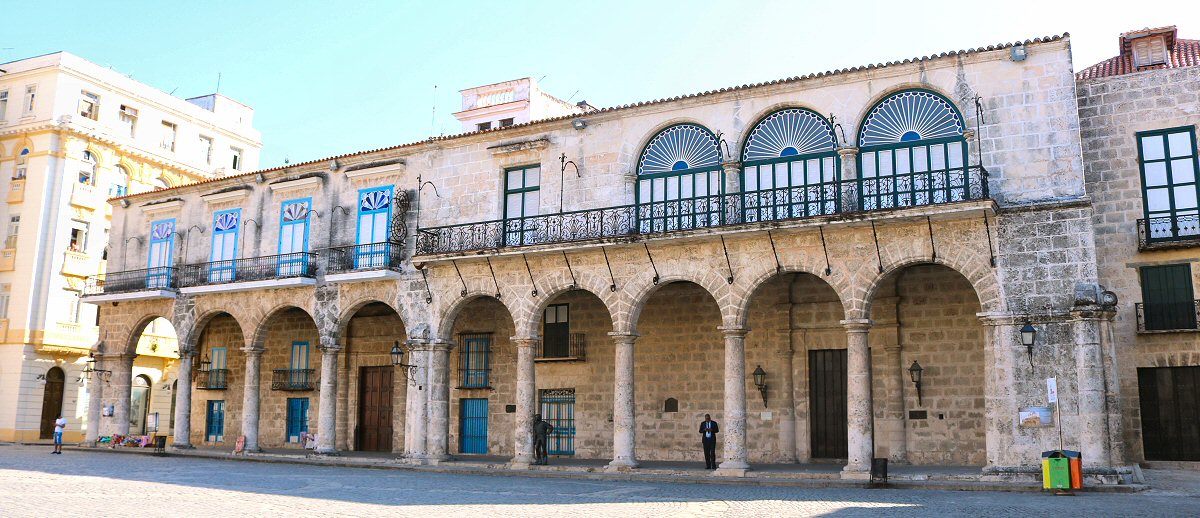HISTORY
The Casa del
Marqués de Arcos was inhabited first by Dr. Francisco Teneza,
the founder of the Protomedicato de la Habana, an
illustrious physician who practiced for many years in the
city and was recognized by the Crown with the title of
Protomedic of Havana. The house consisted of only one floor
in 1707. When he wanted to enlarge his house by including
about seven meters from the Plaza de Ciénaga (currebtly the
Plaza de la Catedral), the Cabildo
allowed him to make a place only for his buggy. When Dr.
Francisco Teneza died in 1741, Diego Peñalvar y Angulo
(1700-1771), the official treasurer of the Royal Savings
Banks, acquired the property and undertook a remodeling in
the building. In fact, he rebuilt the house; an effort that
continued until his death.
The passersby through neighboring alley,
called Doctor Teneza, that connected Mercaderes street to
the Plaza de Ciénaga bothered Diego Peñalvar y Angulo; thus,
he bought also the houses on the other side of the alley. In
1746, he received the necessary approval of the town council
to close the alley and to join both the buildings, although
this action was an infringement of the regulations that
stipulated four exits at minimum for all plazas.
Furthermore, by the permission of the Governor and the
Captain General, he enlarged his residence, including about
4 meters from the Plaza de Ciénaga. He added the mezzanine
and the upper floor to the building and enlarged the portal
on the Mercaderes street to accommodate the treasury. In
the time of the wealthy man the building, enriched by new
decorations, became a magnificent residence.
When Diego Peñalvar y Angulo
died in 1771, the house was bequeathed to his first son
Ignacio Peñalver y Cárdenas (1736-1804), the General
Treasurer of the Army and the Royal Treasury of Havana,
Honorary Intendant of the Province and Commissar of the
Royal Army. He continued to the constructive process that
his father initiated. He decorated the interior with mural
paintings and constructed the new façade facing the Plazuela
de Cieñaga. In 1792, by a Royal Decree he received the title
of Marqués de Arcos, and from then on, the mansion was
called as the Casa del Marqués de Arcos.
When Ignacio Peñalver y Cárdenas, the
second Marqués de Arcos, died in 1804, the property fell
into the hands of his son Ignacio Peñalver y Peñalver that
had the Grand Cross of the Order of Isabel la Católica. In
1828 Ignacio Peñalver y Peñalver decided to live in a new
residence at the intersection of the Acosta and the
Inquisidor streets (the south segment of the Mercaderes
street after the Muralla street) and rent the property to
the Post Office. In 1842 the Post Office moved to the
Basilica Menor de San Francisco de Asís, and the marquess
had to alienate his property and to reside outside of Cuba.
In 1844, on the initiative of Ramón Pintó, the Liceo
Artístico y Literario de la Habana (1844-1869) was
established in the building to promote fine arts and
literature among the habaneros. Ramón Pintó was a journalist
and politician that, despite being Spanish, sacrificed his
life for the freedom of Cuba. During these years, the old
mansion also housed the Escuela de Pintores Muralistas (the
School of Mural Painters), that took part in the decoration
of the walls of the lyceum. In this period the upper floor
was paved with marble.
In 1869 the lyceum was closed by the
Spanish government, and Rafael María de Mendive, member of
the board of the lyceum, was imprisoned and sent to exile in
Spain for 4 years. Rafael María de Mendive had great impact
on the education of José Martí. It is said that Martí
received the fundamental concepts about freedom, decorum,
dignity, prestige, justice, concern for the humble, purity
of thought from Rafael María de Mendive. Other members of
the board of the lyceum left the country or joined the
Liberation Army. Subsequently the mansion was subdivided for
accommodation of some families and part of it was used as a
warehouse; all these accelerated its deterioration and it
became a tenement house.
In 1934, it was
declared National Monument. In 1935, the Secretariat of
Public Works carried out a general restoration in the Plaza
de la Catedral, directed by the architect Luis Bay Sevilla.
1940 Emilio Roig de Leuchsenring was appointed Curator of
the Plaza de la Catedral and its buildings. In 1962, the
ground floor was taken over by the Taller Experimental de Gráfica de La Habana (Experimental Graphic Workshop of
Havana). In 1995, the restoration process began
to recover this
architectural jewel of the Plaza de la Catedral,
but several times stopped due to lack of financing and
materials. The objectives of the restoration were to exhibit
the exponents of a museum in the old domestic spaces that
allude to the aristocratic habanera house of the 19th
century, to recreate the Goldsmith's Workshop and its
history to preserve the imprint of the first artistic trade,
to have spaces for exhibitions, conferences and debates that
would reveal the ancient Cuban culture, and to create a
commercial corridor,
interconnecting the Mercaderes street with the Plaza de la
Catedral. Currently the Liceo
Artístico y Literario de la Habana is re-established by the Japanese government,
donating the audiovisual
equipment. Its entrance is from the Mercaderes street.

